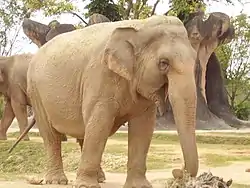アジアゾウ属
アジアゾウ属(Elephas)は長鼻目ゾウ科属。現生種はアジアゾウのみ[2]であるが、複数の絶滅種がいた。その起源は鮮新世まで遡る。マンモス属に最も近縁である[3]。
| アジアゾウ属 | |||||||||||||||||||||
|---|---|---|---|---|---|---|---|---|---|---|---|---|---|---|---|---|---|---|---|---|---|
 アジアゾウ Elephas maximus | |||||||||||||||||||||
| 分類 | |||||||||||||||||||||
| |||||||||||||||||||||
| 和名 | |||||||||||||||||||||
| アジアゾウ属[1] |
分類
属名Elephasはカール・フォン・リンネによって1758年に命名された[4]。ゾウ科に属し、現生種1種と絶滅種7種から成る[5]。以前はこの属に分類されていたElephas recki(エレファス・レッキー)、Elephas antiquus、Elephas falconeri、Elephas cypriotes は現在パレオロクソドン属(Palaeoloxodon)に分類されている。
- 現生種
以下が絶滅亜種として提案されているが、インドゾウとシノニムと考えられる[2]。
- Elephas maximus sondaicus ジャワゾウ †
- Elephas maximus rubridens –チュウゴクゾウ †
- Elephas maximus asurus – シリアゾウ †
- 絶滅種
- Elephas beyeri – 1911年にフィリピンルソン島で発見[7]。
- Elephas celebensis –1949にスラウェシ島で発見[8]
- Elephas ekorensis – ケニアトゥルカナで発見[5]
- Elephas hysudricus – en:Siwalik hills で1845年に発見[9]
- Elephas hysudrindicus – ジャワ島の更新統[10]
- Elephas iolensis
- Elephas platycephalus
脚注
- 川田伸一郎・岩佐真宏・福井大・新宅勇太・天野雅男・下稲葉さやか・樽創・姉崎智子・横畑泰志 「世界哺乳類標準和名目録」『哺乳類科学』第58巻 別冊、日本哺乳類学会、2018年、1-53頁。
- Template:MSW3 Proboscidea
- Fleischer, R. C.; Perry, E. A.; Muralidharan, K.; Stevens, E. E. & Wemmer, C. M. (2001). “Phylogeography of the Asian Elephant (Elephas maximus) based on mitochondrial DNA”. Evolution 55 (9): 1882–1892. doi:10.1111/j.0014-3820.2001.tb00837.x. PMID 11681743.
- Linnaei, C. (1760). “Elephas maximus”. Caroli Linnæi Systema naturæ per regna tria naturæ, secundum classes, ordines, genera, species, cum characteribus, differentiis, synonymis, locis. Tomus I. Halae Magdeburgicae: Ioannes Ioachimus Langius. p. 33
- Maglio, V.J. (1973). "Origin and evolution of the Elephantidae". Transactions of the American Philosophical Society, Philadelphia Volume 63. American Philosophical Society, Philadelphia, pp. 149
- Fernando, P., Vidya, T.N.C., Payne, J., Stuewe, M., Davison, G., et al. (2003). DNA Analysis Indicates That Asian Elephants Are Native to Borneo and Are Therefore a High Priority for Conservation. PLoS Biol 1 (#1): e6
- Von Königswald, G.H.R. (1956). Fossil mammals from the Philippines. National Research Council of the Philippines, Manila
- Hooijer, D.A. (1949). Pleistocene Vertebrates from Celebes. IV. - Archidiskodon celebensis nov spec.. Zoologische Mededelingen Museum Leiden, 30 (#14): 205–226.
- Falconer, H. & Cautley, P. T. (1846). Fauna Antiqua Sivalensis, Being the Fossil Zoology of the Sewalik Hills. Smith, Elder & Company, London, pp. 64.
- Hooijer, D. A. (1955). Fossil Proboscidea from the Malay Archipelago and the Punjab. Zoologische Verhandelingen, 28 (#1): 1–146.
This article is issued from Wikipedia. The text is licensed under Creative Commons - Attribution - Sharealike. Additional terms may apply for the media files.